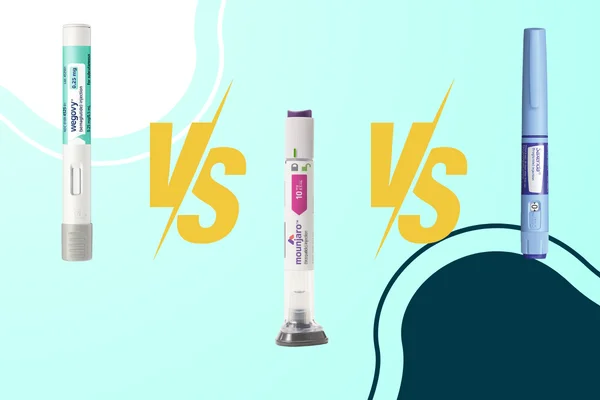The pharmaceutical market now has novel anti-obesity drugs and anti-diabetic medications which may work coherently to improve the health of individuals. Semaglutide, tirzepatide and liraglutide are novel agents which are prescribed to individuals by a certified medical practitioner.
These medications are commonly known as Wegovy and Mounjaro and Saxenda
These 3 innovative drugs are instrumental in the management of diabetes and weight. The function of the 2 incretin hormones found in the gut form the basis of the mechanism of drug action. They act as incretin hormone mimetics.
Glucagon-like peptide-1 receptor agonist (GLP-1 RA) and glucose dependent insulinotropic polypeptide (GIP) are incretins which share similarity in terms of structure and function but exhibit diverse properties and functions.
Functions of GIP
- GIP possesses the ability to reach the pancreas and stimulate increased secretion of insulin by the beta cells.
- It helps decrease the secretion of gastrin and stomach acid.
- Helps in beta cell proliferation.
- Improves lipid metabolism.
- Improves white adipose tissue storage.
- May decrease visceral fat.
Functions of GLP-1 RA
- Helps suppress appetite.
- Increase satiety leading to decreased hunger.
- Decrease hunger
- Decrease food intake.
- Decreases gastrointestinal motility leading to delayed gastric emptying.
The current form of the medication available in the market are subcutaneous injections which improve the bioavailability of the drug.
To help decide which drug may be suitable for an individual, the following table provides specific details
Semaglutide vs Tirzepatide vs Liraglutide
| Categories | Semaglutide | Tirzepatide | Liraglutide |
| Trade names | Ozempic, Wegovy, Rybelsus | Mounjaro and Zepbound | Victoza and Saxenda |
| Year of FDA approval | Ozempic (December 5, 2017) Rybelsus (September 20, 2019) | Mounjaro (July 21, 2022) Zepbound (May, 2022) | Victoza (January 25, 2010) Saxenda (December 24, 2014) |
| Prescription | Ozempic (treats type 2 diabetes) Wegovy (treats individuals with obesity who may or may not have diabetes) Rybelsus (treats type 2 diabetes | Mounjaro (treats type 2 diabetes and obesity) Zepbound (helps treat obesity) | Victoza (treats type 2 diabetes) Saxenda (helps treat obesity) |
| Mode of Action | It mimics GLP-1 | It mimics GIP and GLP-1 | It mimics GLP-1 |
| Dosage and titration | Ozempic (0.25mg, 0.5mg, 1mg) Wegovy (0.25mg, 0.5mg, 1mg, 1.7mg, 2.4mg) Rybelsus (3mg, 7mg, 14mg) | Mounjaro (2.5mg, 5mg, 7.5mg, 10mg, 12.5mg, 15mg) Zepbound (0.5mg, 2.5mg, 5mg, 7.5mg, 10mg, 12.5mg, 15mg) | Victoza (0.6mg, 1.2mg, 1.8mg) Saxenda (3mg) |
| Dosage form | Subcutaneous injection and oral dose | Subcutaneous injection | Subcutaneous injection |
| Age group | Ozempic and Rybelsus can be prescribed to adults above 18 years of age. Wegovy may be prescribed to individuals above 18 years of age and adolescents above 12 years of age. | Mounjaro and Zepbound can be prescribed to adults above 18 years of age. | Saxenda can be prescribed to children of 12-17 years of age without type 2 diabetes mellitus. It can also be used in adults above 18 years of age with type 2 diabetes mellitus. Victoza may be used for children above 10 years of age with type 2 diabetes mellitus. |
| Effectiveness | A study conducted on the effectiveness of semaglutide on 175 individuals revealed a total body weight loss % of 5.9% in 3 months and 10.9% in 6 months. | A study was conducted on 7062 participants. They were given subcutaneous tirzepatide. The results revealed significant changes in body weight, BMI and waist circumference. | A study conducted on the effectiveness of 3mg liraglutide on 311 participants revealed a 6.5% loss of bodyweight. |
| Other benefits |
|
|
|
Similarities of semaglutide, tirzepatide and liraglutide
| Source of procurement | Only through prescription |
| Indications |
Note – A lower BMI (reduced by 2.5 kg/m2) threshold is used for individuals of South Asian, Chinese, other Asian, Middle Eastern, Black African or African Caribbean family backgrounds. Not all drugs may be suitable for paediatric use. |
| Contraindications | The common contraindications of the drugs are –
|
| Risks and side effects (long term) | The common risks of the drugs are –
|
| Side effects (short term) | The short term side effects are predominantly gastrointestinal (GI) manifestations due to the mechanism of action of the drug Gastrointestinal symptoms – Nausea, diarrhoea, vomiting, constipation, abdominal pain, indigestion/dyspepsia, abdominal distension, belching/eructation, gastroenteritis, gastroesophageal reflux disease, headache, fatigue, dizziness, hypoglycaemia, diabetic retinopathy |
| Cost | Expensive than conventional counterparts for weight management or hypoglycaemic agents. The cost may vary depending on market rates |
Note
- Do not combine 1 or more drugs with other weight loss products, prescription drugs, herbal products and over the counter drugs.
- Always read the information label on the drug prescribed.
- Insulin and insulin specific agents may require a change in dosage. The doctor must be kept aware of such medications to avoid severe hypoglycaemia.
- The medication must be coupled with a healthy diet, lifestyle intervention for a sustainable weight loss in the long run.
- There is a potency to regain weight when taken off the drug.
- Always take the medication under a certified medical supervisor.





